Combinatorial Quantification of Multi-Features of Coda Waves in Temperature-Affected Concrete Beams
Abstract
1. Introduction
2. Multi-Feature Decoupling and Combinatorial Quantization Methods
2.1. Feature Extraction
2.2. Establishing the Temperature Identification Model
3. Laboratory Experiments
3.1. Specimens and Equipment
3.2. Data Collection Scheme
3.3. Data Preprocessing
4. Results
4.1. Combined Quantification Results
4.2. Quantification Results Established by a Single Parameter
4.3. Identification Result
5. Conclusions
Author Contributions
Funding
Institutional Review Board Statement
Informed Consent Statement
Data Availability Statement
Conflicts of Interest
References
- Kishida, K.; Imai, M.; Kawabata, J.; Guzik, A. Distributed Optical Fiber Sensors for Monitoring of Civil Engineering Structures. Sensors 2022, 22, 4368. [Google Scholar] [CrossRef] [PubMed]
- Na, W.S.; Baek, J. A Review of the Piezoelectric Electromechanical Impedance Based Structural Health Monitoring Technique for Engineering Structures. Sensors 2018, 18, 1307. [Google Scholar] [CrossRef] [PubMed]
- Yang, M.; Zhang, H.; Ma, X.T.; Zheng, Y.; Zhou, J.T. Quantitative detection of rebar corrosion by magnetic memory based on first-principles. Eng. Res. Express 2024, 6, 015108. [Google Scholar] [CrossRef]
- Boldrin, P.; Fornasari, G.; Rizzo, E. Review of Ground Penetrating Radar Applications for Bridge Infrastructures. NDT 2024, 2, 53–75. [Google Scholar] [CrossRef]
- Zheng, Y.X.; Wang, S.Q.; Zhang, P.; Xu, T.X.; Zhuo, J.B. Application of Nondestructive Testing Technology in Quality Evaluation of Plain Concrete and RC Structures in Bridge Engineering: A Review. Buildings 2022, 12, 843. [Google Scholar] [CrossRef]
- Zhang, J.H.; Peng, L.H.; Wen, S.Z.; Huang, S.L. A Review on Concrete Structural Properties and Damage Evolution Monitoring Techniques. Sensors 2024, 24, 620. [Google Scholar] [CrossRef]
- Han, Q.H.; Xu, J.; Carpinteri, A.; Lacidogna, G. Localization of acoustic emission sources in structural health monitoring of masonry bridge. Struct. Control Health Monit. 2015, 22, 314–329. [Google Scholar] [CrossRef]
- Bogas, A.J.; Gomes, G.M.; Gomes, A. Compressive strength evaluation of structural lightweight concrete by non-destructive ultrasonic pulse velocity method. Ultrasonics 2013, 53, 962–972. [Google Scholar] [CrossRef]
- Planes, T.; Larose, E. A review of ultrasonic coda wave interferometry in concrete. Cem. Concr. Res. 2013, 53, 248–255. [Google Scholar] [CrossRef]
- Snieder, R.; Gret, A.; Douma, H.; Scales, J. Coda wave interferometry for estimating nonlinear behavior in seismic velocity. Science 2002, 295, 2253–2255. [Google Scholar] [CrossRef]
- Lobkis, O.I.; Weaver, R.L. Coda-wave interferometry in finite solids: Recovery of P-to-S conversion rates in an elastodynamic billiard. Phys. Rev. Lett. 2003, 90, 254302. [Google Scholar] [CrossRef] [PubMed]
- Liu, S.; Zhu, J.; Wu, Z. Implementation of coda wave interferometry using Taylor series expansion. J. Nondestruct. Eval. 2015, 34, 25. [Google Scholar] [CrossRef]
- Jean-Baptiste, L.; Zhang, Y.; Odile, A.; Olivier, D.; Vincent, T. Evaluation of crack status in a meter-size concrete structure using the ultrasonic nonlinear coda wave interferometry. J. Acoust. Soc. Am. 2017, 142, 2233. [Google Scholar] [CrossRef] [PubMed]
- Niederleithinger, E.; Wolf, J.; Mielentz, F.; Wiggenhauser, H.E.; Pirskawetz, S. Ultrasonic Transducers for Active and Passive Concrete Monitoring. Sensors 2015, 15, 9756–9772. [Google Scholar] [CrossRef]
- Hafiz, A.; Schumacher, T. Monitoring of stresses in concrete using ultrasonic coda wave comparison technique. J. Nondestruct. Eval. 2018, 37, 1–13. [Google Scholar] [CrossRef]
- Saenger, E.H.; Finger, C.; Karimpouli, S.; Tahmasebi, P. Single-Station Coda Wave Interferometry: A Feasibility Study Using Machine Learning. Materials 2021, 14, 3451. [Google Scholar] [CrossRef] [PubMed]
- Larose, E.; Hall, S. Monitoring stress related velocity variation in concrete with a 2 × 10−5 resolution using diffuse ultrasound. J. Acoust. Soc. Am. 2009, 125, 2641. [Google Scholar] [CrossRef] [PubMed]
- Larose, E.; Rosny, J.D.; Margerin, L.; Anache, D.; Gouedard, P.; Campillo, M.; Tiggelen, V.B. Observation of multiple scattering of kHz vibrations in a concrete structure and application to monitoring weak changes. Phys. Rev. E 2006, 73, 016609. [Google Scholar] [CrossRef] [PubMed]
- Payan, C.; Garnier, V.; Moysan, J. Effect of water saturation and porosity on the nonlinear elastic response of concrete. Cem. Concr. Res. 2009, 40, 473–476. [Google Scholar] [CrossRef]
- Gret, A.; Snieder, R.; Scales, J. Time-lapse monitoring of rock properties with coda wave interferometry. J. Geophys. Res. 2006, 111, B03305. [Google Scholar] [CrossRef]
- Payan, C.; Garnier, V.; Moysan, J.; Johnson, P.A. Determination of nonlinear elastic constants and stress monitoring in concrete by coda waves analysis. Proc. Meet. Acoust. 2008, 3, 045002. [Google Scholar] [CrossRef]
- Moradi-Marani, F.; Kodjo, A.S.; Rivard, P.; Lamarche, C.P. Effect of the Temperature on the Nonlinear Acoustic Behavior of Reinforced Concrete Using Dynamic Acoustoelastic Method of Time Shift. J. Nondestruct. Eval. 2014, 33, 288–298. [Google Scholar] [CrossRef]
- Sthler, S.C.; Sens-Schnfelder, C.; Niederleithinger, E. Monitoring stress changes in a concrete bridge with coda wave interferometry. J. Acoust. Soc. Am. 2011, 129, 1945–1952. [Google Scholar] [CrossRef] [PubMed]
- Wang, X.; Chakraborty, J.; Niederleithinger, E. Noise reduction for improvement of ultrasonic monitoring using coda wave interferometry on a real bridge. J. Nondestruct. Eval. 2021, 40, 14. [Google Scholar] [CrossRef]
- Niederleithinger, E.; Wunderlich, C. Influence of small temperature variations on the ultrasonic velocity in concrete. AIP Conf. Proc. 2013, 1511, 390. [Google Scholar] [CrossRef]
- Zhang, W.X. Acoustic multi-parameter full waveform inversion based on the wavelet method. Inverse Probl. Sci. Eng. 2021, 29, 220–247. [Google Scholar] [CrossRef]
- Niu, Z.; Wang, W.; Huang, X.; Lai, J. Integrated assessment of concrete structure using Bayesian theory and ultrasound tomography. Constr. Build. Mater. 2021, 274, 122086. [Google Scholar] [CrossRef]
- Bompan, K.F.; Haach, V.G. Ultrasonic tests in the evaluation of the stress level in concrete prisms based on the acoustoelasticity. Constr. Build. Mater. 2018, 162, 740–750. [Google Scholar] [CrossRef]
- Ma, B.; Liu, S.; Ma, Z.; Wang, Q.-A.; Yu, Z. Numerical Parametric Study of Coda Wave Interferometry Sensitivity to Microcrack Change in a Multiple Scattering Medium. Materials 2022, 15, 4455. [Google Scholar] [CrossRef] [PubMed]
- Diewald, F.; Epple, N.; Kraenkel, T.; Gehlen, C.; Niederleithinger, E. Impact of External Mechanical Loads on Coda Waves in Concrete. Materials 2022, 15, 5482. [Google Scholar] [CrossRef] [PubMed]
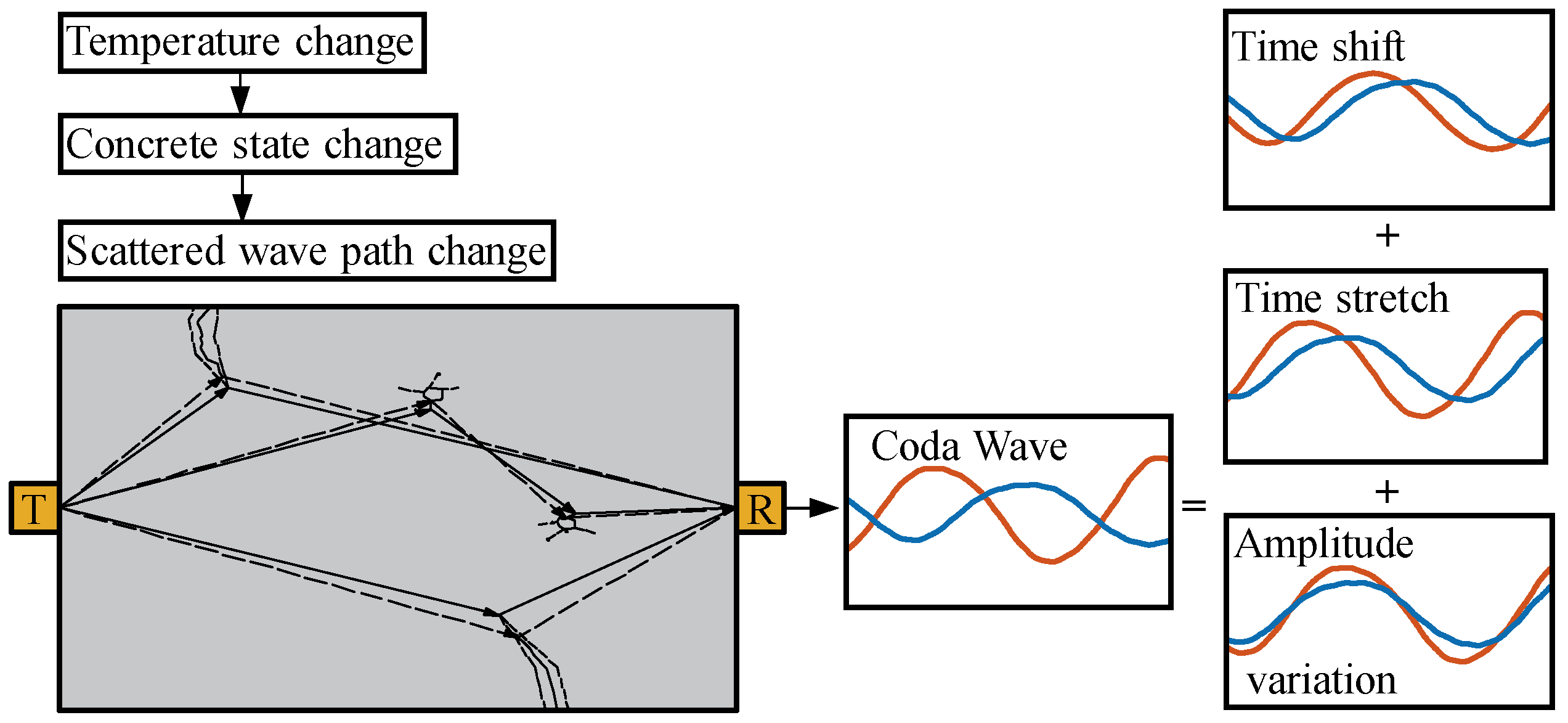
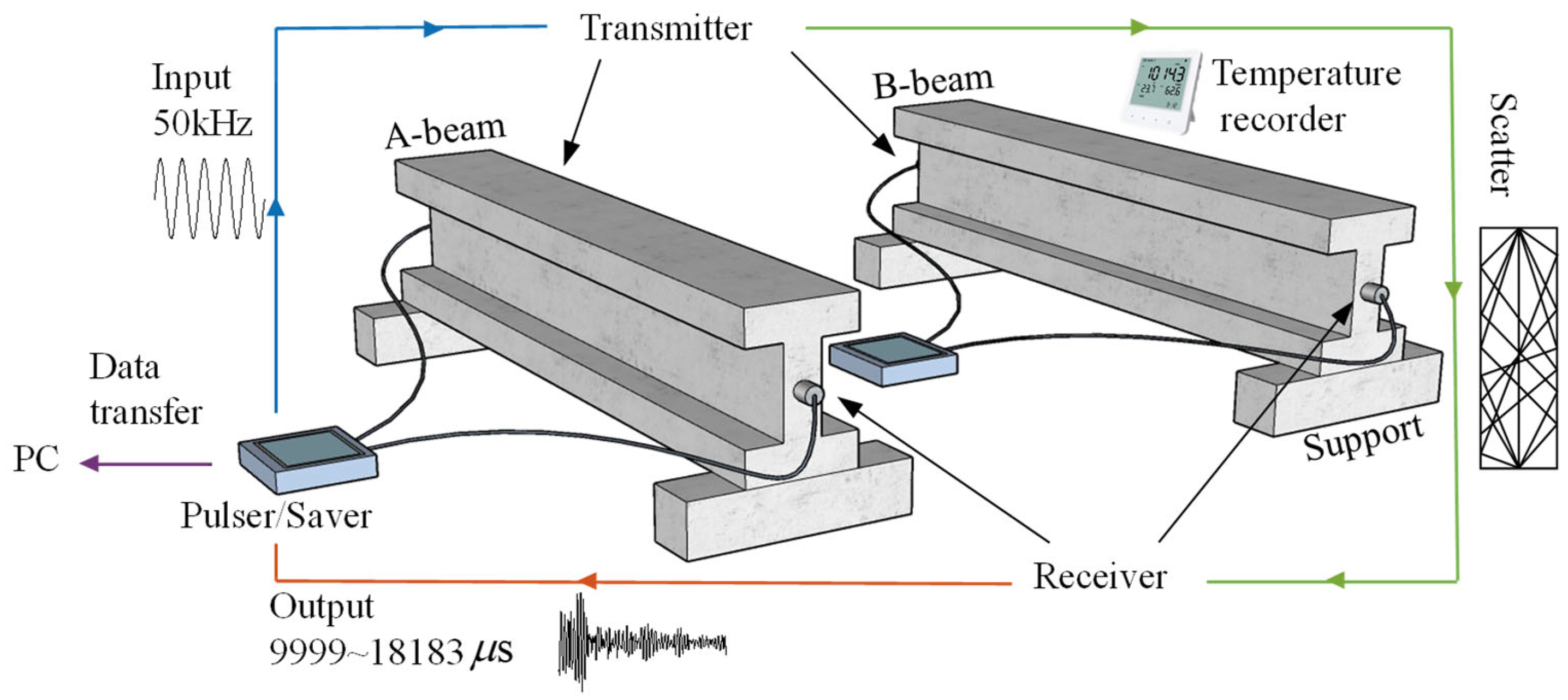

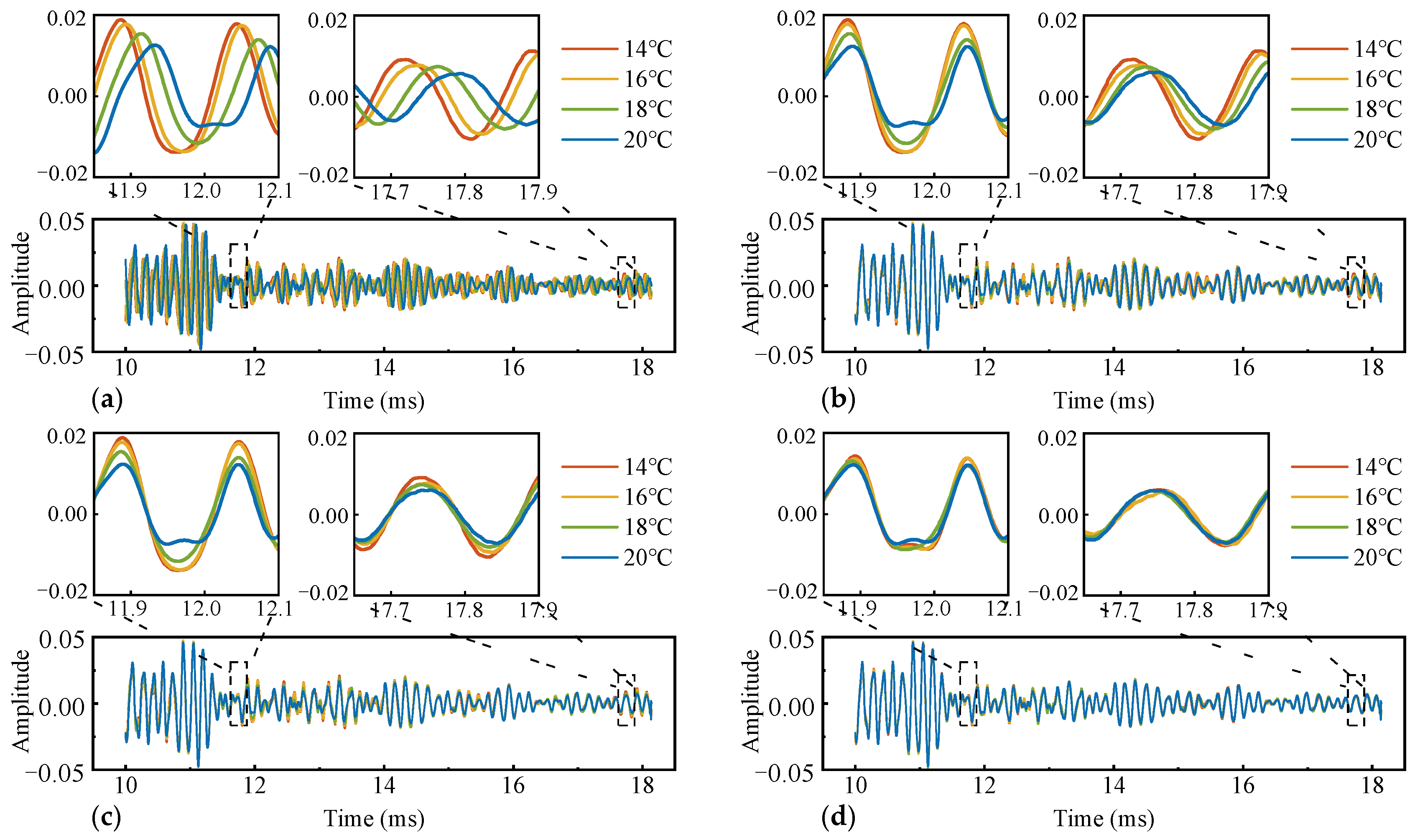
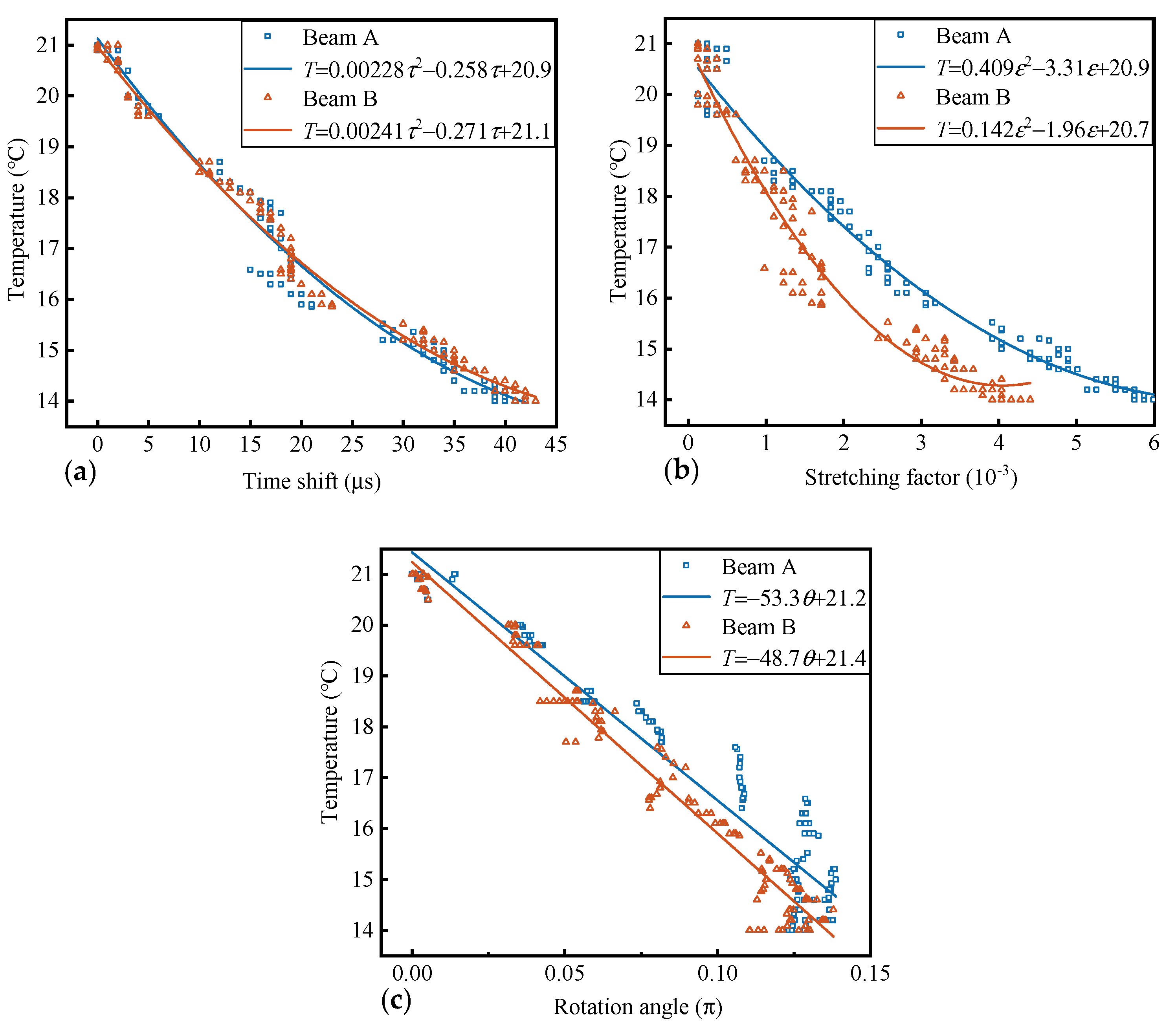

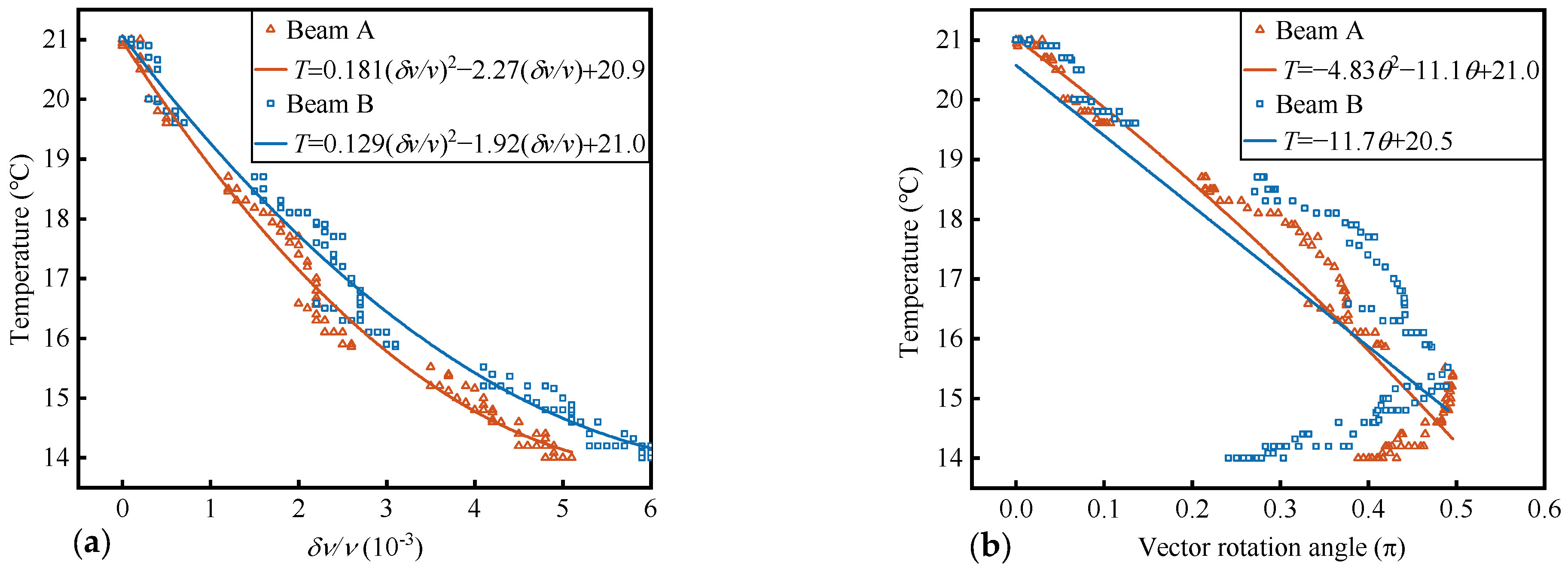

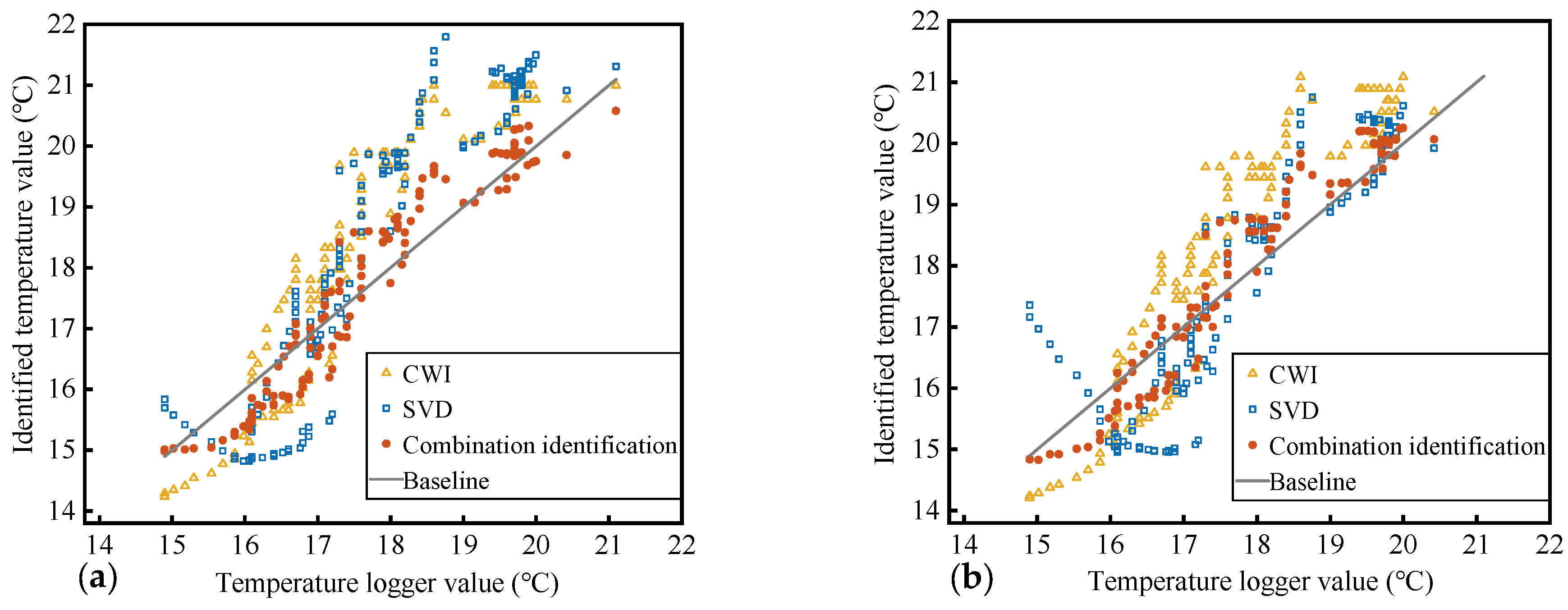
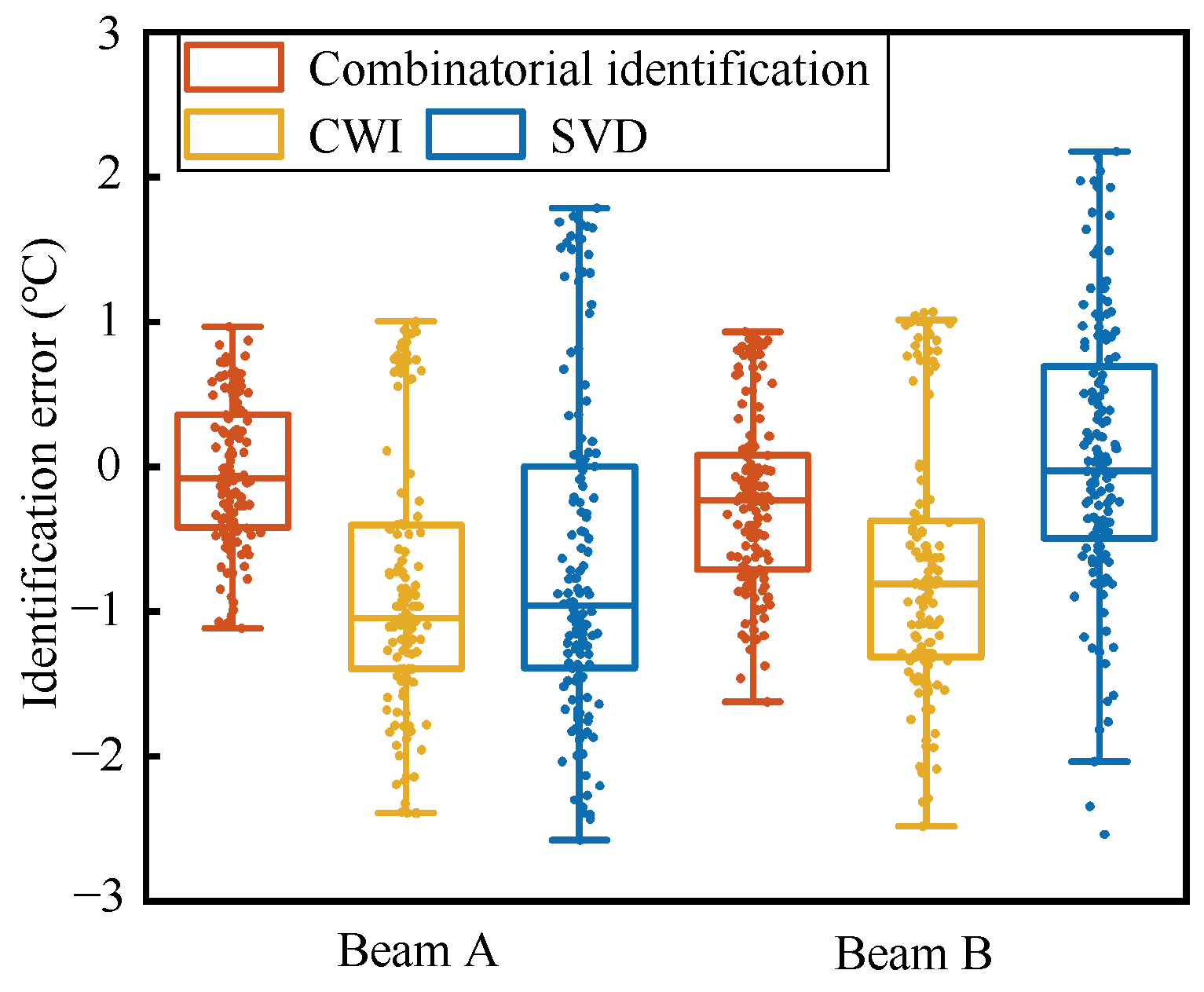
| Raw Data | Preprocessed Data | |
|---|---|---|
| Signal set | 1024 (points/8 μs) × 400 (times) × 14 (groups) × 10 (days) × 2 (phases) | 8177 (points/1 μs) × 140 (items) × 2 (phases) |
| Temperature set | 5 (times) × 14 (groups) × 10 (days) × 2 (phases) | 140 (items) × 2 (phases) |
| Specimen | Methodologies | MAE (°C) | The SD of Absolute Error (°C) |
|---|---|---|---|
| Beam A | CWI | 1.12 | 0.51 |
| SVD | 1.15 | 0.64 | |
| Combinatorial identification | 0.40 | 0.26 | |
| Beam B | CWI | 1.03 | 0.48 |
| SVD | 0.74 | 0.56 | |
| Combinatorial identification | 0.38 | 0.28 |
Disclaimer/Publisher’s Note: The statements, opinions and data contained in all publications are solely those of the individual author(s) and contributor(s) and not of MDPI and/or the editor(s). MDPI and/or the editor(s) disclaim responsibility for any injury to people or property resulting from any ideas, methods, instructions or products referred to in the content. |
© 2024 by the authors. Licensee MDPI, Basel, Switzerland. This article is an open access article distributed under the terms and conditions of the Creative Commons Attribution (CC BY) license (https://creativecommons.org/licenses/by/4.0/).
Share and Cite
Zheng, G.; Song, L.; Xue, W.; Zhang, Z.; Zhang, B. Combinatorial Quantification of Multi-Features of Coda Waves in Temperature-Affected Concrete Beams. Materials 2024, 17, 2147. https://doi.org/10.3390/ma17092147
Zheng G, Song L, Xue W, Zhang Z, Zhang B. Combinatorial Quantification of Multi-Features of Coda Waves in Temperature-Affected Concrete Beams. Materials. 2024; 17(9):2147. https://doi.org/10.3390/ma17092147
Chicago/Turabian StyleZheng, Gang, Linzheng Song, Wenqi Xue, Zhiyu Zhang, and Benniu Zhang. 2024. "Combinatorial Quantification of Multi-Features of Coda Waves in Temperature-Affected Concrete Beams" Materials 17, no. 9: 2147. https://doi.org/10.3390/ma17092147
APA StyleZheng, G., Song, L., Xue, W., Zhang, Z., & Zhang, B. (2024). Combinatorial Quantification of Multi-Features of Coda Waves in Temperature-Affected Concrete Beams. Materials, 17(9), 2147. https://doi.org/10.3390/ma17092147





